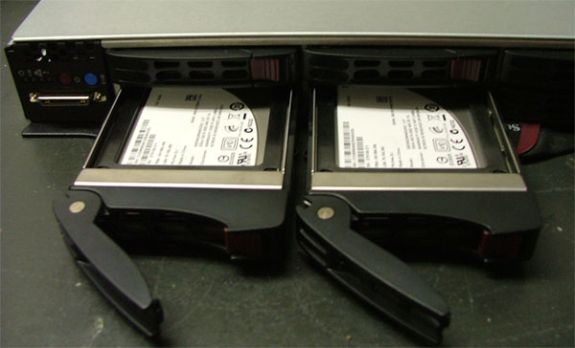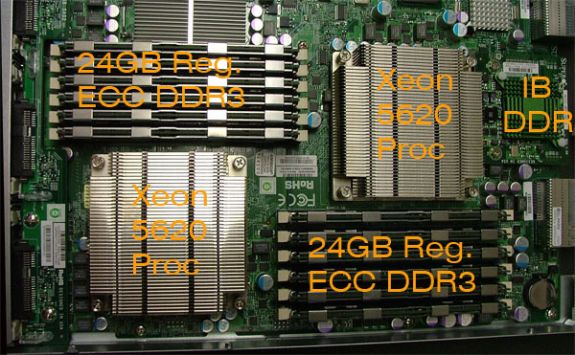ZFS - Building, Testing, and Benchmarking
by Matt Breitbach on October 5, 2010 4:33 PM EST- Posted in
- IT Computing
- Linux
- NAS
- Nexenta
- ZFS
Test Blade Configuration
Our bladecenters are full of high performance blades that we use to run a virtualized hosting environment at this time. Since the blades that are in those systems are in production, we couldn’t very well use them to test the performance of our ZFS system. As such, we had to build another blade. We wanted the blade to be similar in spec to the blades that we were using, but we also wanted to utilize some of the new technology that has come out since we put many of our blades into production. Our current environment is mixed with blades that are running Dual Xeon 5420 processors w/ 32GB
Following that tradition we decided to use the SuperMicro SBI-7126T-S6 as our base blade. We populated it with Dual Xeon 5620 processors (Intel Xeon Nehalem/Westmere based 32nm quad core), 48GB Registered
Front panel of the SBI-7126T-S6 Blade Module
Intel X25-V
Dual Xeon 5620 processors, 48GB Registered
Our tests will be run using Windows 2008R2 and Iometer. We will be testing iSCSI connections over gigabit Ethernet, as this is what most budget
Price OpenSolaris box
The OpenSolaris box, as tested was quite inexpensive for the amount of hardware added to it. Overall costs for the OpenSolaris system was $6765. The breakdown is here :
|
Part |
Number |
Cost |
Total |
|
1 |
$1,199.00 |
$1,199.00 |
|
|
2 |
$166.00 |
$332.00 |
|
|
1 |
$379.00 |
$379.00 |
|
|
1 |
$253.00 |
$253.00 |
|
|
2 |
$378.00 |
$756.00 |
|
|
2 |
$414.00 |
$828.00 |
|
|
2 |
$109.00 |
$218.00 |
|
|
20 |
$140.00 |
$2,800.00 |
|
|
Total |
|
|
$6,765.00 |
Price of Nexenta
While OpenSolaris is completely free, Nexenta is a bit different, as there are software costs to consider when building a Nexenta system. There are three versions of Nexenta you can choose from if you decide to use Nexenta instead of OpenSolaris. The first is Nexenta Core Platform, which allows unlimited storage, but does not have the GUI interface. The second is Nexenta Community Edition, which supports up to 12TB of storage and a subset of the features. The third is their high end solution, Nexenta Enterprise. Nexenta Enterprise is a paid-for product that has a broad feature set and support, accompanied by a price tag.
The hardware costs for the Nexenta system are identical to the OpenSolaris system. We opted for the trial Enterprise license for testing (unlimited storage, 45 days) as we have 18TB of billable storage. Nexenta charges you based on the number of TB that you have in your storage array. As configured the Nexenta license for our system would cost $3090, bringing the total cost of a Nexenta Enterprise licensed system to $9855.
Price of Promise box
The Promise M610i is relatively simple to calculate costs on. You have the cost of the chassis, and the cost of the drives. The breakdown of those costs is below.
|
Part |
Number |
Cost |
Total |
|
1 |
4170 |
$4,170.00 |
|
|
16 |
$140.00 |
$2,240.00 |
|
|
Total |
|
|
$6,410.00 |
How we tested with Iometer
Our tests are all run from Iometer, using a custom configuration of Iometer. The .icf configuration file can be found here. We ran the following tests, starting at a queue depth of 9, ending with a queue depth of 33, stepping by a queue depth of 3. This allows us to run tests starting below a queue depth of 1 per drive, to a queue depth of around 2 per drive (depending on the storage system being tested).
The tests were run in this order, and each test was run for 3 minutes at each queue depth.
4k Sequential Read
4k Random Write
4k Random 67% write 33% read
4k Random Read
8k Random Read
8k Sequential Read
8k Random Write
8k Random 67% Write 33% Read
16k Random 67% Write 33% Read
16k Random Write
16k Sequential Read
16k Random Read
32k Random 67% Write 33% Read
32k Random Read
32k Sequential Read
32k Random Write
These tests were not organized in any particular order to bias the tests. We created the profile, and then ran it against each system. Before testing, a 300GB iSCSI target was created on each system. Once the iSCSI target was created, it was formatted with NTFS defaults, and then Iometer was started. Iometer created a 25GB working set, and then started running the tests.
While running these tests, bear in mind that the longer the tests run, the better the performance should be on the OpenSolaris and Nexenta systems. This is due to the L2ARC caching. The L2ARC populates slowly to reduce the amount of wear on MLC













102 Comments
View All Comments
vla - Tuesday, October 5, 2010 - link
Along the lines of the "Opensolaris is kind of dead" threads, I'd really like to see an article like this for BTRFS. It's about to become the standard filesystems for Fedora and Ubuntu in the near future, and I'd love to get some AnandTech depth articles about it.. what it can do, what it can't. How it compares to existing Linux filesystems, how it compares to ZFS, etc.andersenep - Tuesday, October 5, 2010 - link
When btrfs is ready for production use, let me know. From what I have seen it is still very much experimental. When it's as stable and proven as ZFS, I would love to give it a try. I have severe doubts that Oracle will continue to invest in its development now that it owns ZFS.Khyron320 - Wednesday, October 6, 2010 - link
I have never heard of any caching feature mentioned for BTRFS and it is not mentioned on the wiki anywhere. Is this a planned feature?http://en.wikipedia.org/wiki/Btrfs#Features
Sabbathian - Wednesday, October 6, 2010 - link
Only site where you can find articles like these.... thank you guys ... ;)lecaf - Wednesday, October 6, 2010 - link
Hiwhy not do some extra testing with Windows Storage Server R2 (just released a few days ago)
I'm sure it would lag behind but it could be interesting to see how much.
Mattbreitbach - Wednesday, October 6, 2010 - link
I do not believe that Windows Storage Server is an end-user product. I believe that it is only released to OEM's to ship on their systems. At this time we have no route to obtain Windows Storage Server.lecaf - Wednesday, October 6, 2010 - link
True its OEM only and not public but "evaluation" version is available with Technet and MSDNWithout a license key you can run it for 180 days (like all new MS OS BTW)
but you can also try this
http://www.microsoft.com/specializedservers/en/us/...
Just a registration and you get the software. (Read license because benchmarking is sometimes prohibited)
Sivar - Wednesday, October 6, 2010 - link
BSD supports ZFS as well, and it is far from dead.Of course, it's also far from popular.
Guspaz - Wednesday, October 6, 2010 - link
"We decided to spend some time really getting to know OpenSolaris and ZFS."OpenSolaris is a dead operating system, killed off by Oracle. Points for testing Nexenta, since they're the ones driving the fork that seems to be the successor to OpenSolaris, but basing your article around a dead-end OS isn't very helpful to your readers...
Mattbreitbach - Wednesday, October 6, 2010 - link
When this project was started, OpenSolaris was far from dead. We decided to keep using OpenSolaris to finish the article because a viable alternative wasn't available until three weeks ago. If we were to start this article today, it would be based on OpenIndiana. Some of our preliminary testing of OpenIndiana indicate that it performs even better than OpenSolaris in most tests.